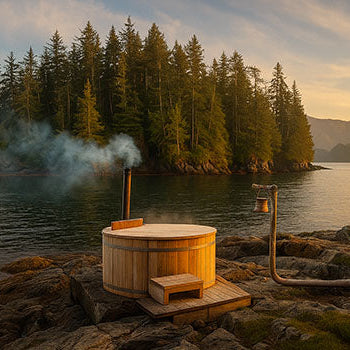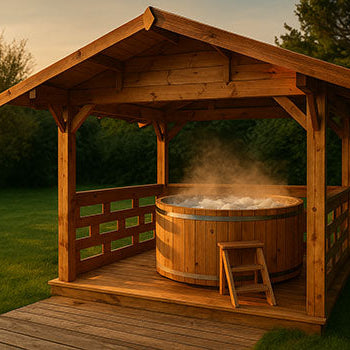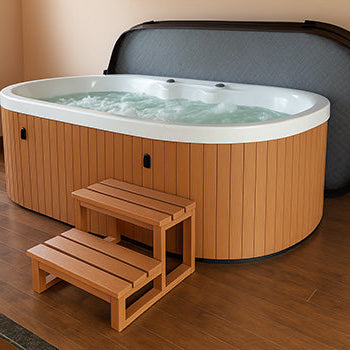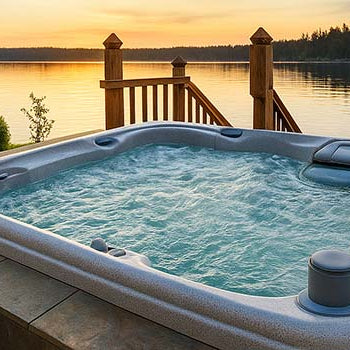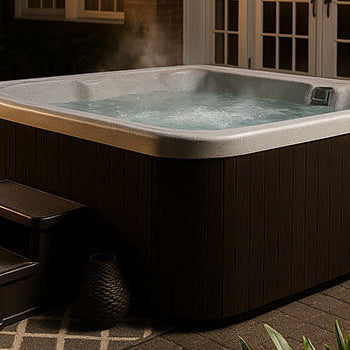Thinking of plonking your hot tub straight on the lawn? Hold that thought.
Short answer: A concrete slab isn’t always essential, but it’s often the most reliable choice.
From sleek Acrylic Hot Tubs to rugged Rotomoulded models and rustic Wooden ones, each type comes with different needs.
Some bases work better than others, depending on what you're soaking in and where.
If you're not sure what to put under your tub, this guide's here to help.
Read on to find the best base for your hot tub and avoid expensive mistakes.

Why a Proper Hot Tub Base is Non-Negotiable
Supporting Significant Weight (Empty and Filled)
Let’s be honest, hot tubs are seriously heavy. Even before you add water, your spa could weigh several hundred kilos. Once filled, some models can exceed 1,500kg, which is about the same as parking a small car in your garden. That kind of weight demands a strong, stable base, one that won’t shift, sink, or crack over time. Without it, you risk structural problems and costly repairs.
Ensuring the Hot Tub Remains Level
A slightly uneven surface might not seem like a big deal, until your hot tub is filled. Unlevel foundations can cause water to pool on one side, affect jet performance, and even lead to internal damage. This is especially critical for Acrylic Hot Tubs, which require precise support to avoid shell strain. A perfectly level base ensures even water distribution and helps your hot tub perform as it should from day one.
Preventing Damage to the Hot Tub Shell and Components
Even the most durable hot tub can suffer without proper support. Cracks in the shell, leaks, or misaligned components often start with a bad base. Hot tubs aren’t built to flex, so setting one on uneven or unstable ground can shorten its lifespan significantly. Even Wooden Hot Tubs, which offer a bit more give, still need a firm, level foundation. The wrong surface can lead to constant issues and premature wear.
Longevity and Stability Considerations
A strong base is more than just a weight-bearer, it’s an investment in your spa’s longevity. The right foundation helps maintain performance, protect internal systems, and extend the life of your hot tub. Even lightweight Rotomoulded Hot Tubs benefit from a well-prepared, stable base. Think of it like a tree: with solid roots, the entire structure thrives. Ignore the base, and you’ll see problems bubble up, literally.
Concrete Slabs: The Traditional Gold Standard
Benefits: Strength, Durability, Longevity
If you're looking for maximum stability, concrete slabs are the go-to option. They’re incredibly strong, weather-resistant, and built to withstand decades of use. Concrete provides a flat, level surface that won’t settle or erode with time. While not the most visually appealing, it’s reliable and nearly maintenance-free once installed. For many, it’s the most dependable choice for a permanent hot tub base.
Typical Requirements: Thickness, Reinforcement
To do it right, your concrete slab should be 4 to 6 inches thick, with steel mesh or rebar reinforcement. Skimping on these essentials can lead to cracking or shifting over time. The ground beneath should be properly compacted and framed before pouring. And don’t rush it, allow full curing time before installing your hot tub. Solid concrete takes time to prep, but the durability it provides is well worth the effort.
Considerations: Cost, Installation Time, Permanence
There are trade-offs, of course. Concrete isn’t cheap or quick. You could spend anywhere from £500 to £2,000, depending on size, ground prep, and location. It also needs time to set and cure, so patience is required. And once it’s installed, it’s not going anywhere. If you plan to move your hot tub in the future, a concrete base adds complexity. Still, for many homeowners, the peace of mind and long-term reliability make it a worthwhile investment.

Reinforced Decking as a Hot Tub Base
Assessing Load-Bearing Capacity (Crucial Step!)
Dreaming of soaking on your deck at sunset? Before you dive in, make sure your decking can handle the load. Even smaller hot tubs put serious pressure on decking boards. Don’t place your spa without confirming the deck’s structural strength, especially for Rotomoulded tubs, which are lighter but still heavy when filled. When in doubt, consult a professional to avoid costly mistakes.
Requirements for Reinforcement (Extra Joists, Posts, Footings)
To safely support a hot tub, your deck will likely need reinforcement. This can include extra joists, thicker beams, deeper footings, and more vertical posts to distribute weight evenly and prevent shifting or sagging. Don’t cut corners here, using quality materials and smart design is far cheaper than repairing a collapsed deck. When done right, a reinforced deck can easily support a full spa setup.
Consulting Structural Engineers or Experienced Builders
This isn’t a time for guesswork. A structural engineer or qualified builder can assess the load-bearing capacity of your deck and recommend what’s needed. They’ll help you ensure your setup is safe, compliant, and built to last. Plus, they may streamline the planning approval process in some areas. A little expert input now can save a major headache later.
Pros and Cons of Deck Placement
Decking looks fantastic and can make your hot tub more accessible, especially on sloped or uneven terrain. However, it can be more expensive than other base options and may require permits depending on your location. It also takes more time to build or reinforce. Still, for many homeowners, the aesthetic appeal and easy access are well worth the investment. Just take your time and get it done right.
Patios and Paver Bases
Using Existing Patios (If Suitable and Level)
Already have a patio? Good news, you may be able to use it as a hot tub base. But first, make sure it’s flat, crack-free, and built on a solid sub-base. Check for signs of movement or poor drainage, and ensure it can handle the full weight of your hot tub. If everything checks out, you’re in luck, you’ve already got a ready-made base.
Constructing a Dedicated Paver Base (Proper Compaction Needed)
No patio? No problem. A custom paver base can be built from scratch. Start with compacted hardcore and sand, then top it off with thick, high-quality pavers. Use a tamper or plate compactor on each layer to ensure strength and stability. A well-prepped base means fewer issues down the line and a tub that stays perfectly in place.
Ensuring Levelness and Stability
Don't rely on your eyes, use a long spirit level to check for evenness. Even a minor slope can throw off water levels and affect performance. Use levelling sand or spacers to correct small dips or angles. Also, secure the perimeter to prevent shifting over time. The result is a clean, solid, and reliable foundation for your spa.
Compacted Gravel Bases
Construction Method: Frame, Geotextile Fabric, Hardcore, Gravel Layers
Gravel is a solid DIY option when built properly. Start by creating a timber frame to keep everything contained. Lay geotextile fabric to prevent weeds and soil displacement, then add compacted hardcore topped with decorative gravel. Aim for a total depth of 6 to 8 inches, and ensure each layer is firm and level. Done right, it’s both functional and attractive.
Importance of Proper Compaction and Leveling
Never skip the compaction step. Loose gravel will lead to sinking, pooling water, and uneven support. Use a plate compactor or tamper on each layer to make everything solid. Take your time here, this is where most gravel bases fail. Proper compaction means a smooth, long-lasting spa experience.
Suitability and Potential Drawbacks
Gravel bases are affordable, drain well, and blend nicely into natural landscapes. They're ideal for areas where concrete isn’t an option or when you prefer a more casual look. However, they may require occasional maintenance, and in areas with heavy rain or erosion, they’re not the best fit. Still, when installed correctly, a gravel base can be a low-cost, high-reward solution.

Pre-Fabricated Hot Tub Pads (e.g., EZ Pads)
Description and Materials
Pre-fabricated hot tub pads offer a convenient, ready-made base solution. Typically made from high-strength plastic or rubber, these lightweight, modular panels snap together to create a durable, level surface. There’s no need for mixing, pouring, or curing, making them ideal for temporary setups or renters. Some models even feature built-in drainage channels to help manage water flow.
Ease of Installation and Portability
Installation couldn’t be easier, just lay the pads on a prepared surface and snap them into place. If you move house, you can take them with you, making this a great option for non-permanent installations. However, it’s still important to prepare the ground properly, a base of compacted gravel or crushed stone is recommended to ensure long-term stability.
Weight Distribution and Ground Preparation Needs
Even though prefab pads are sturdy, they can’t do it all alone. You still need solid ground preparation. That means clearing vegetation, levelling the area, and laying a stable sub-base such as compacted gravel. The pad is only as strong as what’s underneath it, so think of it as the final layer, not the full foundation.
Unsuitable Bases to Avoid
Placing Directly on Grass or Soil
It might feel like a quick fix, but placing a hot tub directly on grass or soil is a bad idea. These surfaces are unstable, absorb moisture, and shift over time. The result? Your hot tub could tilt, sink, or become uneven within weeks. Fixing the damage can be difficult and expensive, so it’s best to avoid this shortcut altogether.
Uneven or Unstable Surfaces
Stay away from any surface that isn’t flat, firm, and reliable. That includes sand, mulch, sloped ground, or old, unstable decking. If the base wobbles, absorbs water, or shifts with the weather, it’s not suitable. Your hot tub needs a foundation that’s built to last, reliable, level, and weather-resistant.
Conclusion: Choosing the Right Foundation for Your UK Hot Tub
So, do you need a concrete slab? Not necessarily. But it remains one of the most durable and dependable options, especially for heavier Acrylic Hot Tubs.
That said, reinforced decking, paver patios, gravel pads, and pre-fab bases can all work beautifully, as long as the groundwork is done right. Don’t underestimate the importance of a level, well-prepared surface.
Whether you're setting up a Rotomoulded Hot Tub on a gravel pad or a Wooden Hot Tub on reinforced decking, the message is the same:
Your hot tub needs a strong foundation to function properly and last longer.
It’s more than just a base, it’s the support system for your investment in relaxation and comfort.
